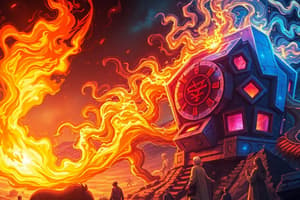Podcast
Questions and Answers
What is produced during complete combustion?
What is produced during complete combustion?
- Soot and carbon
- Carbon dioxide, water, and energy (correct)
- Carbon monoxide and soot
- Oxygen and carbon dioxide
Incomplete combustion can result in carbon monoxide, which is odorless and highly toxic.
Incomplete combustion can result in carbon monoxide, which is odorless and highly toxic.
True (A)
Name one common symptom of carbon monoxide poisoning.
Name one common symptom of carbon monoxide poisoning.
Headaches
Incomplete combustion occurs when the oxygen supply is ______.
Incomplete combustion occurs when the oxygen supply is ______.
Match the following types of combustion with their characteristics:
Match the following types of combustion with their characteristics:
Flashcards
Combustion
Combustion
A chemical reaction where fuel rapidly reacts with oxygen, producing oxides (like carbon dioxide) and energy. Think of burning wood for a campfire.
Complete Combustion
Complete Combustion
When all the fuel burns completely with enough oxygen, producing only carbon dioxide, water, and energy. Think of a blue flame on a gas stove.
Incomplete Combustion
Incomplete Combustion
When there isn't enough oxygen for the fuel to burn fully, producing carbon monoxide, carbon, carbon dioxide, water, and energy. Think of a flickering orange flame.
Carbon Monoxide
Carbon Monoxide
Signup and view all the flashcards
Hydrocarbons
Hydrocarbons
Signup and view all the flashcards
Study Notes
Combustion
- Combustion is a rapid chemical reaction between a fuel and oxygen, producing oxides and energy.
- Two types of combustion exist: complete and incomplete.
Complete Combustion
- Complete combustion uses all the fuel, producing only carbon dioxide, water, and energy.
- This requires an abundant oxygen supply.
- A key reaction is: Hydrocarbon(CxHy) + Oxygen (O2) → Carbon Dioxide (CO2) + Water (H₂O) + Energy
Incomplete Combustion
- Incomplete combustion occurs with limited oxygen supply.
- Often indicated by an orange flickering flame.
- Products include carbon monoxide, carbon, carbon dioxide, water, and energy.
- Visible soot indicates incomplete combustion, leading to pollution and energy waste.
- A key reaction is: Hydrocarbon(CxHy) + Oxygen(O₂) → Carbon monoxide(CO) + carbon(C) + carbon dioxide(CO₂) + water (H₂O)+ energy
Dangers of Incomplete Combustion
- Carbon monoxide (CO) is a highly toxic, odorless, and colorless gas.
- Symptoms of CO poisoning include headaches, dizziness, nausea, and respiratory problems.
- These symptoms can be mistaken for other illnesses.
- CO is often produced by incomplete combustion of fuels in enclosed spaces, like a car engine running in a closed garage.
Studying That Suits You
Use AI to generate personalized quizzes and flashcards to suit your learning preferences.




